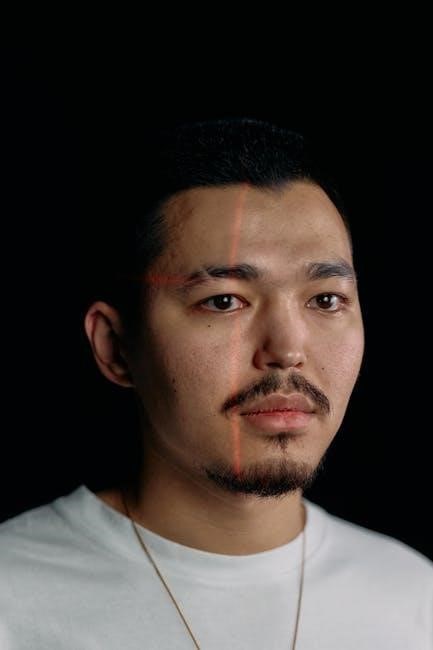Freud’s psychoanalytic theory introduces the id, ego, and superego as essential components of the human psyche, shaping behavior and mental processes through their dynamic interaction.
1.1 Overview of Freud’s Psychoanalytic Theory
Freud’s psychoanalytic theory explores the human psyche through the structural model, comprising the id, ego, and superego. It examines unconscious motivations, conflicts, and defense mechanisms, providing insights into behavior, emotions, and mental health. This framework emphasizes the interplay between instinctual desires and societal norms, shaping personality and psychological functioning. Understanding these concepts is fundamental to analyzing human behavior and mental processes.
1.2 Importance of Understanding the Ego and the Id
Understanding the ego and id is crucial for grasping human behavior, decision-making, and psychological health. The ego mediates between the id’s instincts and reality, influencing actions and mental well-being. This knowledge aids in addressing conflicts, managing emotions, and developing therapeutic strategies, promoting emotional balance and personal growth by understanding these fundamental psychological components.

Freud’s Psychoanalytic Theory
Freud’s psychoanalytic theory explores the unconscious mind, proposing that behavior is driven by the interaction of the id, ego, and superego, shaping thoughts, emotions, and actions.
2.1 The Structural Model of the Psyche
Freud’s structural model divides the psyche into the id, ego, and superego. The id seeks immediate gratification, while the ego mediates between reality and instinct, and the superego embodies moral principles. This framework explains how internal conflicts influence behavior and mental health, providing a foundation for understanding human psychological dynamics and therapeutic interventions.
2.2 Historical Context and Development
Freud introduced the structural model in the 1920s, refining his earlier topographic model. The id, ego, and superego emerged as distinct components, with the id operating on the pleasure principle and the ego mediating reality. Influenced by Groddeck, Freud emphasized the ego’s role in balancing instinct and reality, shaping psychoanalysis into a comprehensive theory of human behavior and mental processes.
The Id: Structure and Function
The id operates on the pleasure principle, seeking immediate gratification of basic desires and instincts, functioning unconsciously as the primitive core of the psyche.
3.1 Definition and Role in the Unconscious Mind
The id is the primitive part of the mind, present from birth, operating unconsciously to seek immediate pleasure and satisfy basic biological urges without moral considerations, driving instinctual behavior and forming the foundation of the psyche according to Freud’s theory.
3.2 The Pleasure Principle and Its Implications
The pleasure principle, driven by the id, seeks immediate gratification of basic desires, operating unconsciously without regard for reality or morality. This innate mechanism prioritizes short-term satisfaction, often leading to conflict with societal norms and the ego’s reality principle, highlighting the id’s primitive and instinctual nature in shaping behavior and mental processes.

The Ego: Structure and Function
The ego operates on the reality principle, mediating between the id’s desires and external reality to achieve socially acceptable outcomes through decision-making and rational thinking.
4.1 The Reality Principle and Decision-Making
The ego’s reality principle guides decision-making by balancing the id’s immediate desires with external constraints, enabling individuals to act appropriately and delay gratification. This function ensures actions align with societal norms and personal goals, fostering rational thought and adaptive behavior; The ego thus serves as a mediator, promoting realistic and socially acceptable outcomes in various situations.
4.2 Ego Development and Maturity
Ego development progresses from childhood to adulthood, shaped by experiences and interactions with the environment. A mature ego adapts effectively to reality, integrating the superego’s moral standards while managing the id’s impulses. This development fosters emotional regulation, rational decision-making, and a balanced personality. A well-developed ego enhances resilience, enabling individuals to cope with stress and maintain psychological well-being throughout life.

The Relationship Between the Id and the Ego
The id seeks immediate gratification, while the ego mediates between instincts and reality, ensuring survival and social harmony by balancing these opposing forces effectively.
5.1 Conflict and Cooperation in the Psyche
The id and ego are in constant interplay, with the id demanding instant satisfaction and the ego striving to delay gratification. This dynamic creates internal conflict, as the ego must balance the id’s impulses with societal expectations. Cooperation emerges when the ego successfully mediates, allowing both instinctual needs and external realities to coexist harmoniously, promoting psychological equilibrium and adaptive behavior.
5.2 Balancing Instinct and Reality
The ego mediates between the id’s instinctual demands and the constraints of reality, ensuring survival and social harmony. By delaying gratification, the ego aligns primitive urges with practical outcomes, fostering adaptive behavior. This balance prevents impulsive actions driven solely by the id, promoting long-term well-being and emotional stability in the face of conflicting desires and external pressures.
The Role of the Superego
The superego embodies moral principles and societal values, guiding behavior toward right actions and self-ideal, influencing decisions beyond instinct and reality.
6.1 Moral Development and Conscience
The superego emerges as a moral compass, guiding individuals toward ethical behavior by incorporating societal values and ideals. It operates as a conscience, producing feelings of guilt when actions contradict internalized standards, thus promoting alignment with moral principles and fostering a sense of right and wrong in decision-making processes.
6.2 Interaction with the Id and Ego
The superego interacts with the id by repressing its primitive demands, while guiding the ego to align actions with moral principles. This dynamic balance ensures behavior conforms to societal expectations, mediating between instinctual desires and ethical standards to maintain psychological harmony and moral integrity.

Defense Mechanisms of the Ego
Defense mechanisms, like repression and projection, protect the ego from stress by distorting reality, helping maintain psychological stability and prevent emotional overload.
7.1 Common Defense Mechanisms Explained
Defense mechanisms are unconscious strategies the ego uses to cope with stress. Repression involves burying painful memories, while projection attributes one’s unacceptable desires to others. Denial rejects reality, and displacement redirects emotions to safer targets. These mechanisms aim to protect the ego from anxiety but can hinder personal growth if overused or maladaptive.
7.2 Impact on Mental Health
Excessive reliance on defense mechanisms can lead to mental health issues like anxiety and depression. Repression of emotions may cause psychological distress, while projection can strain relationships. Chronic use of maladaptive defenses can hinder personal growth and emotional well-being, necessitating therapeutic intervention to address underlying conflicts and promote healthier coping strategies.
Developmental Stages of the Ego
The ego evolves from childhood to adulthood, shaped by interactions and experiences. It mediates between the id’s impulses and reality, fostering maturity and adaptive behaviors over time.
8.1 From Childhood to Adulthood
The ego develops from childhood, where it begins as primitive and egocentric, gradually maturing through social interactions and environmental influences. As individuals grow, the ego learns to balance the id’s demands with reality, fostering decision-making skills and emotional regulation. This developmental journey is crucial for forming a stable and adaptive personality in adulthood.
8.2 Factors Influencing Ego Development
Ego development is shaped by family dynamics, cultural norms, and social interactions. Parental guidance, peer relationships, and societal expectations play significant roles in fostering maturity. Personal experiences, such as overcoming challenges or receiving feedback, also contribute to ego growth. These factors collectively influence how individuals develop self-awareness, decision-making skills, and emotional resilience, ultimately shaping their personality and behavior over time.

Practical Applications in Psychotherapy
Psychotherapy leverages ego-based techniques like cognitive restructuring and defense mechanism insights to balance id-driven impulses, fostering emotional resilience and healthier decision-making processes in individuals.
9.1 Techniques and Strategies
Psychotherapeutic techniques focus on enhancing ego functions, such as reality testing and impulse control. Strategies include cognitive-behavioral approaches to manage id-driven desires, promoting self-awareness and adaptive coping mechanisms. These methods help patients balance unconscious instincts with conscious decision-making, fostering emotional stability and personal growth through structured and goal-oriented interventions.
9.2 Case Studies and Examples
Case studies illustrate how the ego and id manifest in real-life scenarios. For example, a patient struggling with emotional immaturity may exhibit id-dominated behavior, seeking immediate gratification. Through therapy, the ego strengthens, enabling better decision-making. Another example involves overeating, where the id’s pleasure principle clashes with the ego’s reality principle, highlighting the need for balance. Such cases demonstrate psychotherapy’s role in mediating these conflicts.

Current Research and Modern Perspectives
Modern psychology expands Freud’s concepts, integrating neuroscience and cognitive theories. Research explores how the ego and id interact with consciousness, offering new insights into mental processes and behavior.
10.1 Contemporary Views on the Ego and Id
Modern psychological research revisits Freud’s concepts, blending them with cognitive science and neurobiology. The ego is now seen as an adaptive system managing reality, while the id remains the primitive source of drives. Contemporary views emphasize their dynamic interplay in shaping behavior, stress responses, and decision-making, offering a more holistic understanding of human psychology and emotional regulation.
10.2 Advances in Psychological Research
Recent studies integrate neuroimaging and behavioral experiments to explore the ego and id’s roles. Research highlights how the ego’s regulatory functions correlate with prefrontal cortex activity, while the id’s impulses align with limbic system processes. These findings bridge Freudian theory with modern neuroscience, enhancing our understanding of mental structures and their influence on cognition, emotion, and behavior in contemporary psychological frameworks and applications.
Criticisms and Controversies
11.1 Alternative Psychological Theories
Behaviorism and humanistic psychology challenge Freud’s concepts, emphasizing observable behavior and personal growth over unconscious structures. Jung’s analytical psychology introduces the collective unconscious, offering a contrasting view of the psyche’s functioning and development, while cognitive theories focus on mental processes rather than instinctual drives, providing diverse perspectives on human psychology and behavior that differ from Freudian models.
Behaviorism, led by Skinner, focuses on observable actions, rejecting Freud’s unconscious structures. Humanistic psychology, championed by Rogers, emphasizes personal growth and self-actualization, contrasting with Freud’s deterministic views. Cognitive theories, like Beck’s, highlight mental processes over instinctual drives. Jung’s analytical psychology introduces the collective unconscious, diverging from Freud’s ego-id framework. These theories provide diverse perspectives, challenging Freud’s concepts and offering alternative understandings of human behavior and mental processes.
11.2 Debates and Challenges
Freud’s theories face criticism for lacking empirical support and being overly deterministic. Some argue the ego-id framework is too abstract, making it difficult to test scientifically. Cultural variations in behavior challenge the universality of Freud’s concepts. Additionally, modern psychology often views the ego and id as less rigid constructs, integrating them with other theories. These debates highlight the complexities of Freud’s work and its evolving interpretation in contemporary psychology.
Everyday Manifestations of the Ego and Id
The ego and id manifest daily in behavior, influencing decisions and emotions. The id seeks immediate gratification, while the ego mediates reality, balancing desires with societal expectations.
12.1 Behavioral and Psychological Disorders
Imbalances between the ego and id can lead to psychological disorders, such as anxiety or impulsivity. When the id dominates, impulsive behaviors may arise, while a weak ego can result in poor decision-making. Additionally, unresolved conflicts between the two may contribute to low self-esteem or self-regulation issues, highlighting the importance of their balanced interaction for mental health.
12.2 Impact on Daily Life and Interactions
The ego and id significantly influence daily interactions, as their balance affects decision-making and behavior. For instance, the id’s desire for immediate gratification, like taking a cookie, may clash with the ego’s reality principle, fostering self-control. This dynamic impacts relationships, emotional stability, and social functioning, illustrating Freud’s theory in real-life scenarios, such as resisting temptations or managing stress effectively.
Freud’s psychoanalytic theory, focusing on the ego and id, remains foundational in psychology, significantly influencing mental health practices, personal growth, and relationships, and continues to evolve with modern insights.
13.1 Summary of Key Concepts
Freud’s psychoanalytic theory introduces the id and ego as fundamental components of the psyche. The id operates on the pleasure principle, seeking immediate gratification, while the ego follows the reality principle, mediating between instinctual desires and external demands. Their dynamic interaction is central to shaping behavior, decision-making processes, and mental health, offering profound insights into human psychology, emotional development, and therapeutic interventions.
13.2 Influence on Modern Psychology and Beyond
Freud’s concepts of the ego and id have profoundly shaped modern psychology, influencing therapeutic practices and cognitive-behavioral approaches. The ego’s role in mediating reality and the id’s drive for immediate gratification remain central to understanding human behavior. These ideas continue to evolve, informing contemporary research on mental health, emotional regulation, and therapeutic interventions, ensuring their enduring relevance in psychological theory and practice.